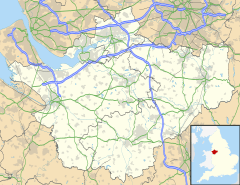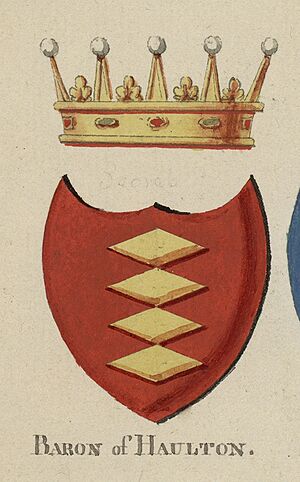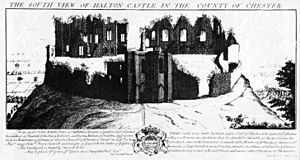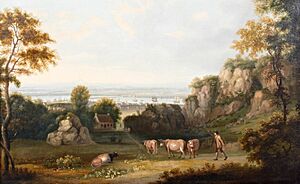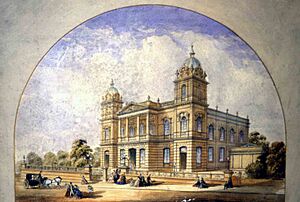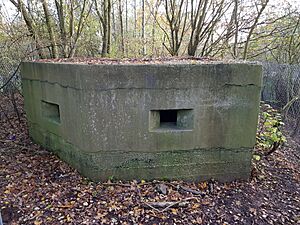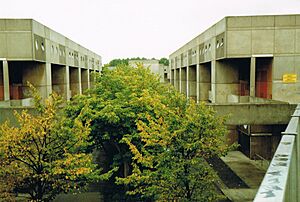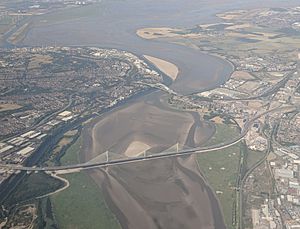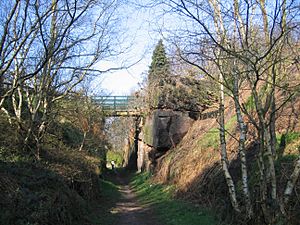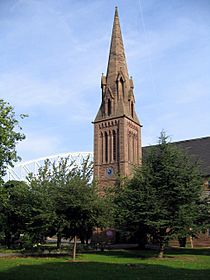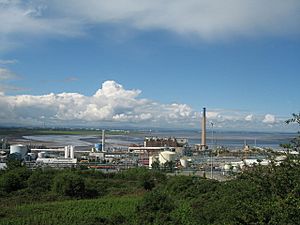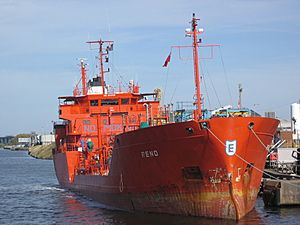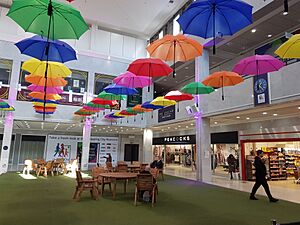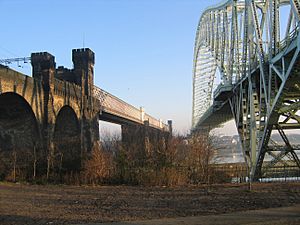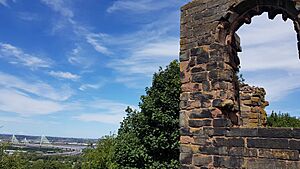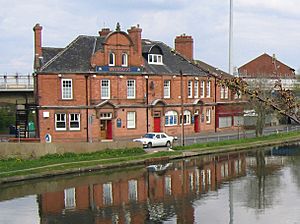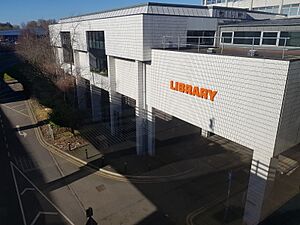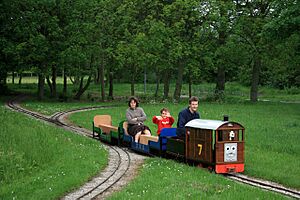Runcorn facts for kids
Quick facts for kids Runcorn |
|
|---|---|
| Town | |
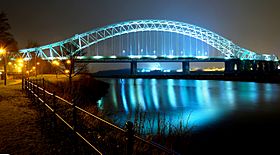 Runcorn's Silver Jubilee Bridge |
|
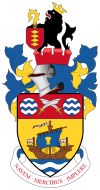 Coat of arms |
|
| Population | 62,100 (2021) |
| Demonym | Runcornian |
| OS grid reference | SJ 5140 8300 |
| • London | 167 mi (269 km) SE |
| Unitary authority | |
| Ceremonial county | |
| Region | |
| Country | England |
| Sovereign state | United Kingdom |
| Post town | RUNCORN |
| Postcode district | WA7 |
| Dialling code | 01928 |
| Police | Cheshire |
| Fire | Cheshire |
| Ambulance | North West |
| EU Parliament | North West England |
| UK Parliament |
|
Runcorn is a town in Cheshire, England, known for its industries and port. In 2021, about 62,100 people lived here. Runcorn is located on the south side of the River Mersey, where the river gets very narrow. It's about 15 miles (24 km) upstream from the big port city of Liverpool.
Runcorn was started way back in 915 AD by Æthelflæd of Mercia. She built a fort here to protect against Viking attacks. Later, in 1115, a special church called an Augustinian abbey was built. For a long time, Runcorn stayed a small village.
Things changed a lot during the Industrial Revolution. In 1776, the Bridgewater Canal was extended to Runcorn. This made it an important port, connecting Liverpool with places like Manchester and Staffordshire. Industries like shipbuilding and stone quarrying grew quickly. For a while, Runcorn was even a health resort! But then, polluting factories, especially soap and chemical works, took over.
In 1964, Runcorn was chosen to become a "new town". This meant it grew a lot, taking in nearby villages and more than doubling its population.
Today, three bridges cross the River Mersey and the Manchester Ship Canal at Runcorn: the Silver Jubilee Bridge, Mersey Gateway, and Runcorn Railway Bridge. Because of its location between Liverpool and Manchester, and its good links to roads, railways, and canals, Runcorn is a hub for making things, moving goods, and shopping. The town's motto is Navem Mercibus Implere, which is Latin for "fill the ship with goods."
Contents
History of Runcorn
How Runcorn Got Its Name
The first time Runcorn was written about was in an old book called the Anglo-Saxon Chronicle. It was spelled "Rumcofan," which means "a wide cove or bay." This name comes from old English words: "rúm" (wide) and "cofa" (cave or cove). Over time, the spelling changed to things like "Rumcoven" and "Runckhorne."
Early Days and Roman Times
We don't know much about Runcorn's very early history. But people have found tools and items from the Stone Age, Bronze Age, and Iron Age here. There's also proof that the Romans were in the area.
The first big event recorded was in 915 AD. Æthelflæd, a powerful queen, built a fort at Runcorn. This fort was on Castle Rock, looking over the River Mersey. It helped protect her kingdom of Mercia from the Vikings.
Medieval Runcorn and Castles
After the Norman conquest of England, Runcorn wasn't mentioned in the 1086 Domesday Book. But the surrounding areas were. William the Conqueror gave the area to Hugh d'Avranches, who then gave the Barony of Halton to Nigel. Nigel probably built a motte and bailey castle on Halton Hill around the 1070s.
In 1115, Nigel's son, William Fitznigel, started an Augustinian Priory in Runcorn. This priory was later moved to Norton in 1134. By 1391, it became an abbey. However, in 1536, during the Dissolution of the Monasteries, the monastery was closed down. Its buildings were sold to Sir Richard Brooke, who turned part of the abbey into a house.
In 1565, a grand house called Rocksavage was built in Clifton, which is now part of Runcorn.
The English Civil War
During the English Civil War, Halton Castle was held by the Royalists. But it was captured twice by the Roundheads, who supported Parliament. After these battles, in 1646, it was decided that the castle should be damaged so it couldn't be used as a fort again.
By 1656, Runcorn was described as just "a fair parish church, a parsonage and a few scattered tenements." It stayed a small, quiet village for over a hundred years. The only way to cross the River Mersey here was by a ferry.
Runcorn's Industrial Growth
In the 1700s, water travel improved with new canals like the Bridgewater Canal. This connected Runcorn to many places inland and to the sea, helping the Port of Runcorn grow.
More canals were built, like the Runcorn to Latchford Canal and the Weston Canal. These made it even easier to transport goods.
New industries started to appear in Runcorn. These included shipbuilding, engineering, chemical making, leather tanning, and sandstone quarrying. For a short time, in the late 1700s and early 1800s, Runcorn was even a health resort! People called it the "Montpelier of England." In 1822, the first Saltwater Baths opened, and new places for visitors were built.
As the town became richer, new buildings were constructed in the mid-1800s. These included Halton Grange, St Paul's Methodist Chapel, and All Saints' Church.
For hundreds of years, the only way to cross the Mersey was by ferry. In 1868, the first bridge, the Runcorn Railway Bridge, finally opened. This connected Runcorn directly to Liverpool by train.
Runcorn quickly became an industrial town with a lot of pollution. Chemical and tanning industries became very important. In the 1880s, a pipeline brought salt water to the salt works. In 1896, the Castner Kellner chemical works was built.
In 1894, the Manchester Ship Canal opened. This allowed large ships to sail inland to places like Salford, and some stopped at Runcorn's port. The number of people living in Runcorn changed a lot around this time because many people came to build the ship canal.
In 1905, the Widnes–Runcorn Transporter Bridge opened, allowing cars to cross the river. This bridge was replaced in 1961 by the Runcorn Road Bridge (now called the Silver Jubilee Bridge), making road travel even easier.
During the first half of the 1900s, chemicals and tanning continued to be the main industries. In 1926, four chemical companies joined together to form Imperial Chemical Industries (ICI).
In the second half of the 1900s, the tanning factories closed, and the chemical industry became smaller. At the same time, lighter industries, warehouses, and distribution centers grew.
Runcorn in World War II
In 1937, ICI started building a new factory to make mustard gas at their Randle plant. The ICI chemical plants in Runcorn were on a special list of targets for the German Luftwaffe (air force) in 1940. However, Runcorn was never directly attacked and only had a few bombs dropped on it.
Building the New Town
In 1963, the government decided to make Runcorn a "new town." This meant a large area around Runcorn would be developed to build more homes. The main reason was to help with overcrowding in Liverpool and clear out old, run-down areas there. Runcorn was chosen because it had good roads, railways, canals, plenty of water, and existing industries.
After some discussions, the plan was approved in 1964. The new town plan of 1967 aimed to more than double Runcorn's population. It included new housing areas, special walking paths, a Busway (a road just for buses), lots of green spaces, separate industrial areas, and a new town center.
The new town center was built in the middle of the expanded town. Its main feature was Runcorn Shopping City, a large indoor shopping mall that opened in 1972. This was a big project, and it was opened by Queen Elizabeth II herself!
Much of the new town's architecture was very modern for its time. One famous design was the Southgate Estate, built between 1970 and 1977. However, this housing development had many problems and was taken down in the early 1990s.
How Runcorn is Governed
Runcorn's Parliament Members
Runcorn is part of the Runcorn and Helsby area for choosing its representative in the UK Parliament. Since 2024, Mike Amesbury from the Labour Party has been the Member of Parliament (MP) for this area.
Before 2024, Runcorn was split between two areas: Weaver Vale and Halton. Both of these areas were represented by Labour MPs.
Over the years, Runcorn has been part of different parliamentary areas. From 1950 to 1983, it had its own area called the constituency of Runcorn.
Geography of Runcorn
What Runcorn Looks Like
Runcorn is on a piece of land that sticks out into the River Mersey. The river flows north and then west around the town. On the other side of the river is Widnes. Together, these two areas form the Runcorn Gap, where the River Mersey becomes very narrow.
The town has some higher areas like Runcorn Hill (75 meters above sea level) and Halton Castle (75 meters above sea level).
Three bridges cross the Runcorn Gap: the Runcorn Railway Bridge, the Silver Jubilee Bridge, and the Mersey Gateway. Runcorn also has a system of dual carriageways (roads with two lanes in each direction) called 'expressways'. These roads form a figure-of-eight shape around the town. The Central Expressway goes through the middle of Runcorn, connecting to the M56 motorway in the south.
The older part of Runcorn, Higher Runcorn, and some new town areas are to the west of the Central Expressway. To the east are the villages of Halton and Norton, and more new town areas. Runcorn has many houses, but also lots of green spaces, like the heathland on Runcorn Hill and the big Town Park.
Runcorn's Rocks and Soil
The water in the Runcorn area flows into the River Mersey in the north and the River Weaver in the south.
The main rock under Runcorn is Sherwood Sandstone. In the south, there's also Mercia Mudstone. The top layer of soil and rocks is different in various places, with sand and gravel common in some areas.
Nature in Runcorn
Runcorn has two special nature areas called Sites of Special Scientific Interest: Floodbrook Clough and the Mersey Estuary. Floodbrook Clough is an Ancient Semi-Natural Woodland, which means it's a very old forest.
There are also five Local Nature Reserves in Runcorn. These include Runcorn Hill, Dorchester Park, Oxmoor Woods, Wigg Island, and Murdishaw Valley.
People and Population
How Runcorn's Population Grew
Early records of Runcorn's population only included the older parts of the town. In 1936, the nearby village of Weston became part of Runcorn. The current boundaries of Runcorn were set in 1964 when it became a new town, which made the town much larger.
In 1664, it's thought that about 305 people lived in Runcorn.
| Year | Population | Change as % |
|---|---|---|
| 1801 | 1,379 | — |
| 1811 | 2,060 | +49.4% |
| 1821 | 3,103 | +50.6% |
| 1831 | 5,035 | +62.3% |
| 1841 | 6,951 | +38.1% |
| 1851 | 8,688 | +25.0% |
| 1861 | 10,063 | +15.8% |
| 1871 | 12,066 | +19.9% |
| 1881 | 15,126 | +25.4% |
| 1891 | 20,020 | +32.4% |
| 1901 | 16,491 | −17.6% |
| 1911 | 17,353 | +5.2% |
| 1921 | 18,476 | +6.5% |
| 1931 | 18,127 | −1.9% |
| 1939 | 21,718 | +19.8% |
| 1951 | 23,931 | +10.2% |
| 1961 | 26,035 | +8.8% |
| 1971 | 35,999 | +38.3% |
| 1981 | 64,196 | +78.3% |
| 1991 | 64,952 | +1.2% |
| 2001 | 60,320 | −7.1% |
| 2011 | 61,789 | +2.4% |
| 2021 | 62,100 | +0.5% |
Religions in Runcorn
In the 2021 census, 52.5% of people in Runcorn said they were Christian. This was a decrease from 70.1% in 2011. About 41.5% said they had "no religion," and 4.6% didn't state a religion. A small number (1.3%) followed other religions like Buddhist, Hindu, Jewish, Muslim, or Sikh.
Runcorn has many churches. The Anglican churches are part of the Diocese of Chester. The main church is All Saints Church, and there are 10 other Anglican churches. There are also five Catholic churches.
You can find two Methodist chapels and several churches that are shared by different Christian groups. For example, Wicksten Drive Christian Centre is used by both Anglicans and Methodists. There are also Pentecostal churches, evangelical churches, a Church of Jesus Christ of Latter-day Saints chapel, a spiritualist church, and a Jehovah's Witnesses Kingdom Hall.
In 2013, a former hotel was turned into a Buddhist temple by Wat Phra Singh.
Different Ethnicities in Runcorn
In the 2021 census, out of Runcorn's 62,100 residents, most (96.6%) identified as White. People from mixed ethnic groups made up 1.5%, Asian groups 1.0%, Black groups 0.4%, and other ethnic groups 0.6%. For 97.4% of residents, English was their first language.
Runcorn's Economy
Runcorn has a lot of people working in manufacturing (making things), logistics (moving goods), and wholesale and retail (selling things). This is more than the average for England. For a long time, making chemicals was the main industry. But now, the local economy has grown to include other advanced manufacturing, like aerospace and car parts, as well as services.
The main industrial areas are Astmoor, Manor Park, Whitehouse, the Heath, and Weston Point. Sci-Tech Daresbury is a science campus near the town. For shopping and fun, the main place is Runcorn Shopping City in the town center.
| Industry | Runcorn (Resident Jobs) | Runcorn (%) | Halton (%) | England (%) | Runcorn – England Difference |
|---|---|---|---|---|---|
| C Manufacturing | 3,829 | 13.7 | 12.5 | 8.8 | 4.9 |
| H Transport and storage | 2,087 | 7.4 | 6.9 | 5.0 | 2.4 |
| G Wholesale and retail trade; repair of motor vehicles and motor cycles | 5,069 | 18.1 | 18.7 | 15.9 | 2.2 |
| N Administrative and support service activities | 1,579 | 5.6 | 5.3 | 4.9 | 0.7 |
| E Water supply; sewerage, waste management and remediation activities | 334 | 1.2 | 1.6 | 0.7 | 0.5 |
| J Information and communication | 1,247 | 4.4 | 3.9 | 4.1 | 0.3 |
| O Public administration and defence; compulsory social security | 1,721 | 6.1 | 6.5 | 5.9 | 0.2 |
| D Electricity, gas, steam and air conditioning supply | 194 | 0.7 | 0.8 | 0.6 | 0.1 |
| Q Human health and social work activities | 3,460 | 12.3 | 12.0 | 12.4 | −0.1 |
| B Mining and quarrying | 40 | 0.1 | 0.2 | 0.2 | −0.1 |
| L Real estate activities | 314 | 1.1 | 1.2 | 1.5 | −0.4 |
| I Accommodation and food service activities | 1,388 | 5.0 | 4.6 | 5.6 | −0.6 |
| A Agriculture, forestry and fishing | 44 | 0.2 | 0.2 | 0.8 | −0.6 |
| F Construction | 1,881 | 6.7 | 7.4 | 7.7 | −1.0 |
| R, S, T, U Other | 988 | 3.5 | 3.8 | 5.0 | −1.5 |
| M Professional, scientific and technical activities | 1,305 | 4.7 | 4.5 | 6.7 | −2.0 |
| K Financial and insurance activities | 555 | 2.0 | 2.4 | 4.4 | −2.4 |
| P Education | 1,993 | 7.1 | 7.7 | 9.9 | −2.8 |
Factories and Chemicals
For many years, the chemical industry in Runcorn was controlled by ICI. Now, a company called Inovyn (part of Ineos) runs the large chemical works in the west of town. In 2020, they employed 750 people. Inovyn makes chlorine, caustic soda, and other chemicals. They also produce salt from brine (salty water) that comes through a pipeline from central Cheshire.
Other chemical companies also work at this site. The site is very important for the UK. It has two power stations: the Rocksavage Power Station (which uses natural gas) and the Runcorn Energy Recovery Facility, which also provides heat to the Inovyn factory. ICI's old offices are now the Heath Business and Technical Park, offering offices, labs, and conference facilities.
Other big companies in Runcorn include Sigmatex (which makes carbon fiber), Héroux-Devtek (aircraft landing gear), Whitford (special coatings), Teva (medicines), and Fresenius Kabi (medical products). The drinks company Diageo has had a factory in Runcorn since 1970, where they package drinks like Guinness and Smirnoff Ice.
Sci-Tech Daresbury is a big science and innovation campus southeast of Runcorn. It has labs, offices, and workshops for rent. It's home to one of Europe's largest supercomputers and a Virtual Engineering Centre that works with companies like Bentley and Jaguar Land Rover. The site also has Daresbury Laboratory, where over 300 staff work on science projects.
Moving Goods Around
Runcorn is great for moving goods because it's between Liverpool and Manchester airports. It also has good connections to railways, motorways, and canals. There are two ports in the west of town on the Manchester Ship Canal: Runcorn Docks and Weston Point Docks.
Several large logistics companies have depots in Runcorn. These include Eddie Stobart Group (road transport), Downton (haulage), and an NHS Supply Chain Depot.
Services and Shopping
Over the years, more people in Runcorn have started working in service industries instead of manufacturing. In 1991, 34% worked in manufacturing and 61% in services. By 2004, only 17% were in manufacturing, while 78% were in service jobs.
Runcorn has two main shopping areas. The older part of town has High Street, but it has become less busy since the new town was built. In the center of the new town is Runcorn Shopping City, a large indoor mall with two bus stations. Next to it is Trident Retail Park, which has shops and a cinema. There's also a big Asda superstore that opened in 1989.
Getting Around Runcorn
The Runcorn New Town plan created three types of roads: busways, expressways, and local roads. There are also special paths just for bikes.
The Runcorn Busway was the first system of its kind in the world, opening in 1971. It's a network of roads only for buses. It's completely separate from other roads. The idea was that most people would be no more than a five-minute walk from a bus stop. The main bus station is at Runcorn Shopping City.
The expressways form a ring road around the town. They are designed to keep traffic off the smaller local roads. These roads connect Runcorn to Widnes and Liverpool (via the A533 and Mersey Gateway bridge), Warrington (via the A56), Northwich (via the A533), and the M56. The M56 connects to the M6 and M62.
Runcorn has two train stations. Runcorn station in the old town has trains to Liverpool and London Euston. You can also get trains to Birmingham from here. Runcorn East station in the new town has trains to Warrington, Manchester, Chester, and North Wales.
Runcorn is about 8 miles (13 km) from Liverpool John Lennon Airport and 22 miles (35 km) from Manchester Airport.
Famous Places in Runcorn
Runcorn has two very important historic buildings: Halton Castle and Norton Priory. Halton Castle is one of only two Norman castles left in Cheshire. It was built in 1071 and rebuilt with local stone in the 1200s. After the Civil War, it was partly destroyed, and its gatehouse became a courthouse in 1737. Now, it's The Castle pub.
Norton Priory is a museum today. It's the most dug-up monastic site in Europe, with ruins of an Abbey and an 18th-century Walled Garden. Both Norton Priory and Halton Castle are looked after by the Norton Priory Museum Trust.
Many other important buildings are around Halton Castle, like Seneschal's House (built in 1598) and Halton Old Hall (1693). The town's 19th-century Anglican churches are also important buildings, including All Saints (1849) and St John's (1897).
Bridgewater House, the home of the Duke of Bridgewater, is a well-known building by the Manchester Ship Canal. Runcorn Town Hall is another important building, looking like a grand Italian-style house.
The biggest landmarks are the three bridges over the River Mersey and Manchester Ship Canal: Runcorn Railway Bridge, the Silver Jubilee Bridge, and the Mersey Gateway Bridge. The Mersey Gateway Bridge was officially opened by Queen Elizabeth II in 2018. Norton Water Tower is another tall, well-known landmark.
The Runcorn War Memorial remembers those who died in the First and Second World Wars, and later conflicts. It has a statue of Thomas Alfred Jones, a hero from the First World War.
Runcorn Shopping City, in the heart of the New Town, was once the largest covered shopping center in Europe when it opened in 1972.
Culture and Entertainment
Theatre and Cinema
The Brindley is a theatre and arts center that opened in 2004. It's in the old town and named after James Brindley, who engineered the nearby Bridgewater Canal. It has a main theatre that seats 420 people and a smaller theatre, The Studio, which also works as a cinema. There's also an art exhibition space, a small cafe, and other rooms. The Brindley won 'Best Arts Project in the UK' in 2007. A large cinema at Trident Retail Park closed in November 2023.
Media and TV Shows
Runcorn has two weekly newspapers: the Runcorn & Widnes Weekly News and the Runcorn and Widnes World. There's also Halton Community Radio, a volunteer-run radio station that broadcasts on 92.3FM.
Several TV shows have been set in Runcorn. The BBC comedy Two Pints of Lager and a Packet of Crisps was set here, showing places like the former Waterloo Hotel and the Silver Jubilee Bridge. Drop Dead Gorgeous (BBC Three) was also set in Runcorn. Parts of the BBC police drama Merseybeat and the Sky1 crime drama The Five were filmed in Runcorn. Norton Priory has been used as a filming location for historical dramas and children's shows. The Silver Jubilee Bridge was featured in the Netflix series Stay Close. Runcorn was also a setting in the Netflix series The Last Kingdom, though no scenes were filmed in the town itself.
Literature
The Runcorn Ferry is a poem written by Marriott Edgar and made famous by Stanley Holloway. It celebrates the old river crossing that existed for centuries before the Transporter Bridge was built.
Community Life in Runcorn
The main library is at Runcorn Shopping City, and there's another branch in the old town center. A Council 'one stop shop' called Halton Direct Link is next to the main library.
Runcorn has many green spaces that are part of Mersey Forest. Besides smaller local parks, there are four large parks:
- Town Park is in the middle of the eastern part of the New Town. It has a dry ski slope and a miniature railway run by volunteers.
- Phoenix Park is next to Town Park. It has a cafe, a rock climbing wall, a skate park, and a BMX track. There are also walking paths along the Bridgewater Canal and a lake.
- Runcorn Hill Park and Local Nature Reserve is in the western part of town. It used to be a quarry. It has woodlands, heathland, playing fields, and a cafe. You can even see a Chirotherium dinosaur footprint there!
- Wigg Island is a large park and nature reserve by the Mersey and Manchester Ship Canal. It opened in 2002 and has places to watch birds. You reach it by crossing The Old Quay Bridge, a historic swing bridge.
There are also several swimming pools and leisure centers in Runcorn.
Runcorn's hospital is Halton General Hospital. It has an Urgent Care Centre, but serious medical services are provided by Warrington Hospital. The Cheshire and Merseyside Treatment Centre, a hospital for bone surgery, is on the same site. Halton Haven Hospice is in the Murdishaw area.
Cheshire Constabulary has a police station near Runcorn Shopping City. Cheshire Fire and Rescue Service has a 24-hour fire station.
Sports in Runcorn
Football Teams
Runcorn has two main football teams: Runcorn Linnets FC and Runcorn Town FC. There's also a Sunday League, a Junior League, and a women's team called Runcorn Ladies FC.
Runcorn Ladies FC started in 2012. Two years later, they joined with Runcorn Linnets to form Runcorn Linnets Ladies.
Runcorn Linnets was formed in 2006. The club has been around since 1918 in different forms. Their best achievement was winning the Alliance Premier League in 1982.
Runcorn Town started in 1970 as Mond Rangers FC. They changed their name in 2005 to sound more professional. In 2010, they joined the North West Counties Football League, which is the highest level they have played at.
Rugby Teams
In the late 1800s, before the split in rugby, rugby union was played by a team called Runcorn RFC. When rugby split in 1895, Runcorn became one of the founding members of the Northern Rugby Football Union (now Rugby Football League). However, Runcorn stopped playing after the First World War.
Today, rugby league in Runcorn is played by Runcorn RLC.
Other Sports
Runcorn Sports Club in Higher Runcorn is home to several clubs, including Runcorn Cricket Club, Hockey Club, Running Club, and a Bowling Club.
Runcorn Rowing Club is located on the River Weaver Navigation and also hosts Runcorn Canoe Club.
Weston Angling Club Runcorn is a private fishing club.
There's an 18-hole golf course at Runcorn Golf Club. Nearby is Heath Tennis Club.
Runcorn Ski Centre in Town Park has three dry ski slopes where you can learn to ski and snowboard.
Famous People from Runcorn
Artists and Entertainers
- Elizabeth Jocelin (1595–1622), a writer.
- Sir Hall Caine (1853–1931), a famous writer and playwright.
- Alistair Taylor (1935–2004), who worked for The Beatles' company, Apple Corps.
- Anna Keaveney (1949–2004), an actress.
- Martin Roscoe (born 1952), a classical pianist.
- John Bishop (born 1966), a well-known comedian and actor.
- Kym Marsh (born 1976), a singer and actress.
- Susan Nickson (born 1982), a TV writer and producer.
- Nicola Roberts (born 1985), a singer and member of the pop group Girls Aloud.
Business, Industry, and Science
- Thomas Hazlehurst (1779–1842), who started a soap and chemical company.
- Charles Wigg (1824–1899), a chemical manufacturer, after whom Wigg Island is named.
- Hamilton Castner (1858–1899), an American chemist who started a chemical company in Runcorn.
- John Riley Holt (1918–2009), a physics professor who helped develop the atom bomb.
- Ian Gibbons (1946–2013), a biochemist.
Religious Figures
- Thomas Hazlehurst (1816–1876), a Methodist who paid for 12 chapels and three schools to be built in the area.
Sports Stars
- Harry Speakman (1864–1915), a rugby player.
- Robert Done (1904–1982), a footballer.
- Bridget Duke-Wooley (1915–1976), an alpine skier who competed in the 1948 Winter Olympics.
- Robin Reid (born 1971), a boxer.
- Shauna Coxsey (born 1993), a professional rock climber.
- Ian White (born 1970), a darts player.
- Luke Littler (born 2007), a darts player.
Images for kids
See also
 In Spanish: Runcorn para niños
In Spanish: Runcorn para niños


